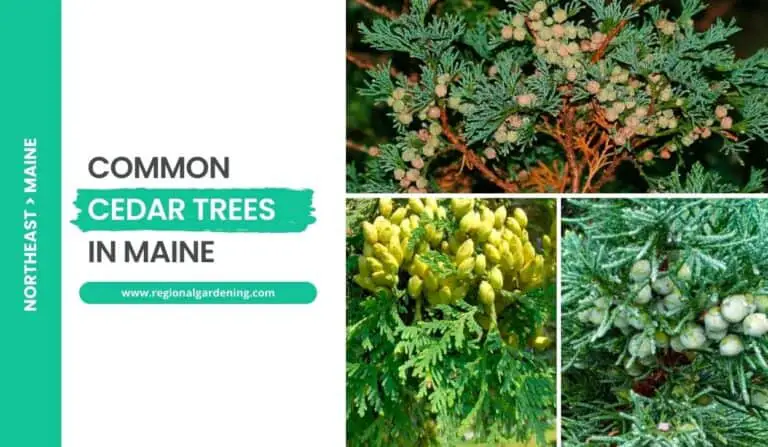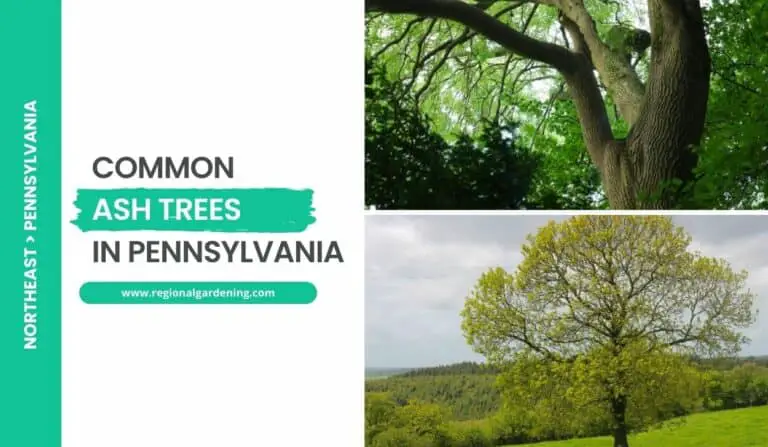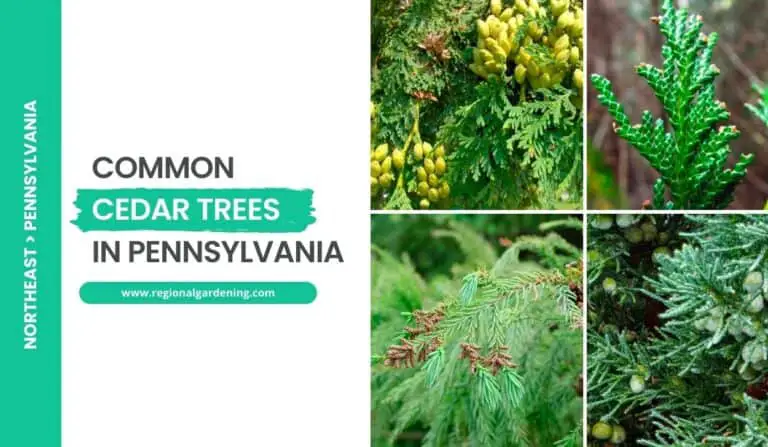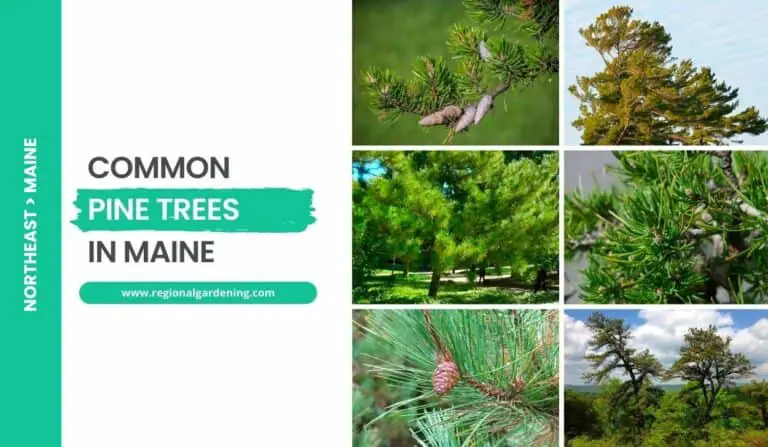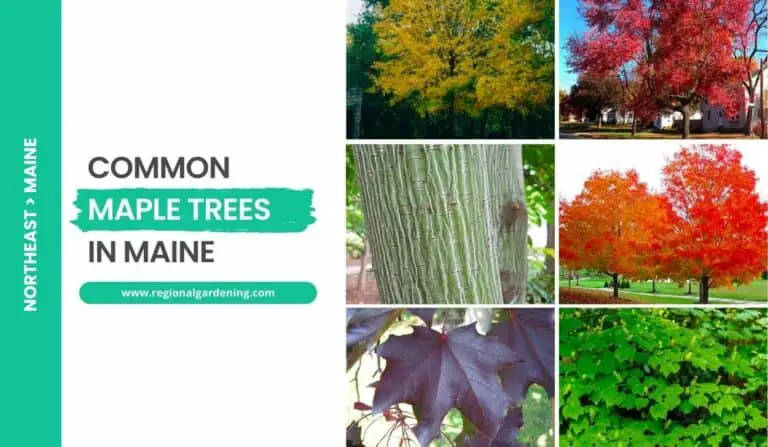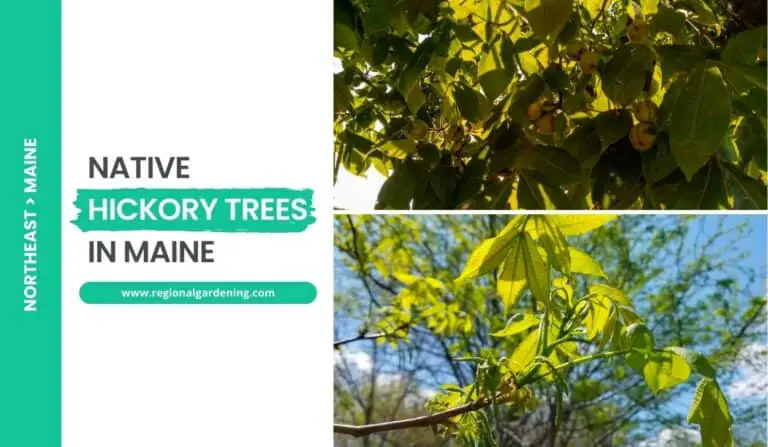6 Common Pine Trees In Pennsylvania (Photos & ID Guide)
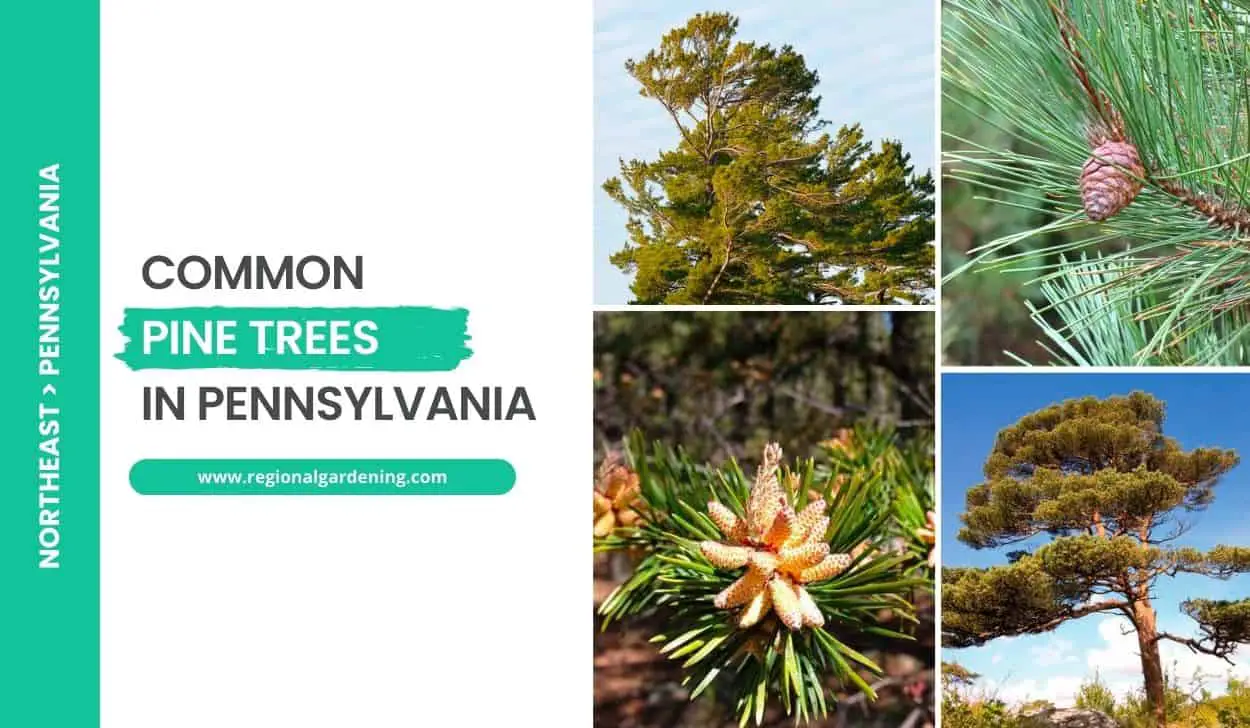
Pine trees in Pennsylvania are spread out across the peaceful landscape like sentinels. They offer peace and shelter to animals and people alike. With their towering height and lush green canopies, these magnificent conifers are an important part of the state’s natural beauty.
In this article, we will learn more about pine trees in Pennsylvania. We will look at six of the most common types that grow there. From the famous Eastern white pine to the stately pitch pine, each tree has its own unique qualities and charms.
So, let’s begin.
1. Pitch Pine
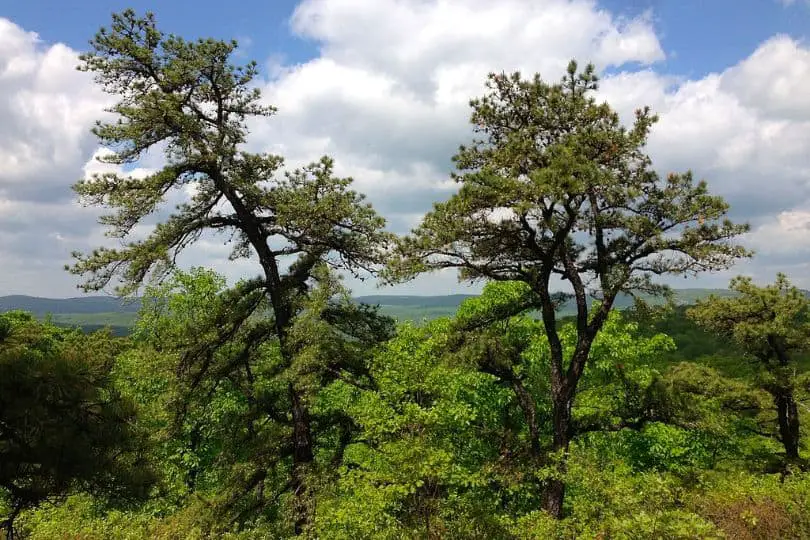
- Scientific Name: Pinus rigida P.Mill
- Common Name(s): Pitch Pine
- Mature Height: 50-60 feet (15-18 meters)
- Native Region: Widespread in Pennsylvania except for the northwestern counties
- Flowers: No Flowers
- Fruit: Cones 2″-3″ long with short, stiff prickles
- Uses: Durable wood for railroad ties, sills of houses and barns, fuel. Pine tar and turpentine production. Seeds are important for wildlife such as nuthatches, Pine grosbeaks, and Black-capped chickadees. Deer and rabbits browse the seedlings.
Pitch pine, technically known as Pinus rigida P.Mill, is a medium-sized evergreen tree found in gardens throughout Pennsylvania. It can grow to heights of 50 to 60 feet (15 to 18 meters) and is found across the northwest counties. Because of its thick bark, which insulates and protects the trunk from injury, this tree is well-adapted to fire-prone regions.
Pitch pine grows in a variety of soil conditions, including poor, sandy soils and highland bogs. Its wood is highly regarded for its toughness and is frequently used for railroad ties, house and barn sills, and fuel. Additionally, pitch pine resinous wood is utilized in the production of pine tar and turpentine.
The tree produces cones that are 2 to 3 inches long and covered in small, prickly prickles. Surprisingly, these cones can stay attached to the tree for up to five years, sometimes waiting for the heat of a passing forest fire to open and release the seeds. Pitch pine seeds are a significant food source for many birds, including nuthatches, Pine grosbeaks, and Black-capped chickadees. Deer and bunnies browse pitch pine seedlings as well.
Pitch pine’s physical traits include evergreen needles that grow in clusters of three. These needles are rigid and range in length from 2 to 6 inches. They are yellowish-green in hue. Pitch pine twigs are sturdy, brittle, and rough, with an angled cross-section. The tree’s buds are egg-shaped, about half an inch long, and resinous, with a red-brown appearance.
When contemplating pitch pine care advice for Pennsylvania landscapes, it is vital to remember that pitch pine is highly versatile and can endure a wide range of soil conditions. It requires well-drained soils and enjoys full sun exposure. While it is low-maintenance, it should be regularly during dry months to guarantee its health and vigor.
2. Red Pine
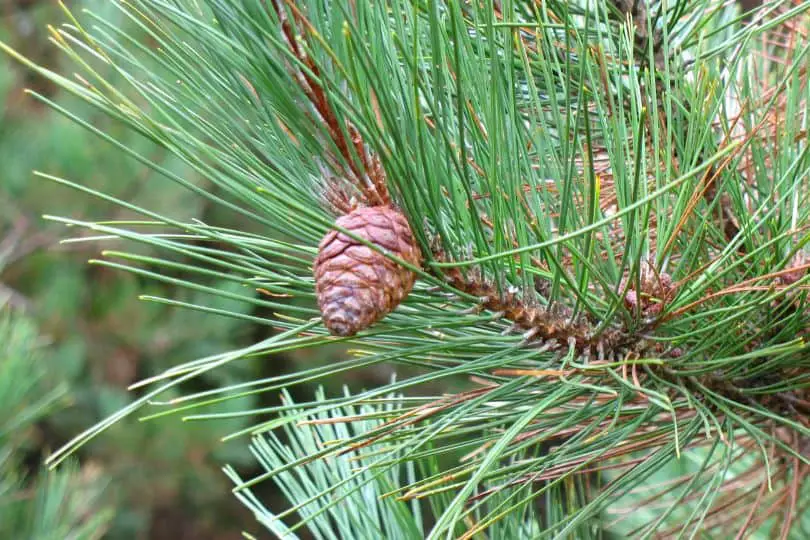
- Scientific Name: Pinus resinosa Ait.
- Common Name(s): Red Pine
- Mature Height: Up to 110 feet (33 meters)
- Native Region: North America
- Flowers: No Flowers
- Fruit: Cones, about 2″ long, without prickles, remain attached until the following year.
- Uses: A valuable timber tree used for construction lumber and pulp.
The Red Pine (Pinus resinosa Ait.) is one of the tallest native pine trees in Pennsylvania. It is endemic to North America and can grow to a mature height of up to 110 feet (33 meters). The
Red Pine has slender, dark green needles that grow in clusters of two. These needles are 4 to 6 inches long and grow in thick tufts at the tips of the branchlets. When the needles are fresh, they snap neatly when bent double.
In terms of physical traits, the Red Pine has sturdy, ridged twigs that range in color from yellow-brown to red-brown. The buds are egg-shaped and about half an inch long, beginning brown and then turning silvery. The bark of the Red Pine is smooth and reddish-brown, with a subtle reddish-orange coloring on the top trunk and branches.
The tree produces cones that are about 2 inches long, have no prickles, and stay connected until the next year.
In the northern portion of Pennsylvania, the Red Pine is highly prized as a timber tree, and its wood is largely utilized for building lumber and pulp. This tree is native to dry hillsides in the counties of Luzerne, Wyoming, Tioga, and Centre. The Bureau of Forestry and the Pennsylvania Game Commission also plant a lot of it. Red Pine seeds are a source of food for songbirds, mice, and chipmunks.
The Red Pine thrives in well-drained soil and full sun to light shade in Pennsylvania gardens. It can grow well in various soil types, including acidic, loamy, sandy, and clay soils. This tree is drought resilient, but it benefits from regular irrigation, especially during dry years. Pruning should be regularly done to keep the tree in good form and health. Mulching around the base of the tree also helps maintain moisture in the soil and inhibits weed growth.
The Red Pine is a fantastic choice for building windbreaks and giving privacy in gardens. Its dense, evergreen foliage provides visual interest all year and can be used as a screen to block out undesired views. This tree also lends a vertical element to the environment, making it an excellent choice for garden designs that require structure and height.
The Red Pine, with its rich lumber, not only improves the aesthetic appeal of Pennsylvania gardens but also adds to the state’s forestry industry.
3. Table Mountain Pine

- Scientific Name: Pinus pungens Lamb.
- Common Name(s): Table Mountain Pine
- Mature Height: 30′-40′ (9-12 meters)
- Native Region: Appalachian region, Pennsylvania
- Flowers: No flowers
- Fruit: Cones 3″-4″ long, sessile, egg-shaped but asymmetrical at the base, in whorls of 2-7. Cone scales are much thickened and tipped with a strong, curved spine.
- Uses: Its small size discourages its use for lumber, but it is valued for erosion control on rocky slopes.
The Table Mountain Pine (Pinus pungens) is a natural tree species of the Appalachian area, including Pennsylvania. It grows to a mature height of 30 to 40 feet (9 to 12 meters). This species is an Appalachian endemic that can be found on dry, rocky, and gravelly slopes as well as ridgetops in Pennsylvania’s southcentral and southeastern counties.
Because of its modest size, Table Mountain Pine is not commonly used for lumber. It is highly prized, however, for its vigorous growth, which makes it ideal for shielding rocky slopes from erosion. Because the tree’s roots effectively maintain the soil and prevent erosion, it is an excellent choice for landscaping projects in Pennsylvania and other places with rocky or steep terrain.
The needle-like leaves of the Table Mountain Pine are grouped in clusters of two. They have a pale bluish-green tint and a strong, hard texture. These needles are twisted with sharp ends and last for roughly 2 to 3 years on the tree. Twigs begin smooth and bright orange to purplish, eventually becoming tough and dark brown.
Table Mountain Pine cones grow to be 3 to 4 inches long. These cones are sessile, or directly attached to the branch, and egg-shaped with an uneven base. The enlarged cone scales are capped with a strong, curving spine, lending to the tree’s overall unusual appearance.
The bark of the Table Mountain Pine is dark reddish-brown. Shallow fractures roughen it, generating uneven plates that frequently peel off in thin sheets. The tree’s visual appeal is enhanced by its distinctive bark texture.
Pennsylvania landscapes that include table mountain pine benefit from full sun and well-drained soils. It is drought-tolerant once established and can withstand rocky, dry, and gravelly conditions. This tree species requires little maintenance once established and can be a useful addition to landscapes that require erosion control on slopes or ridgetops.
4. Virginia Pine
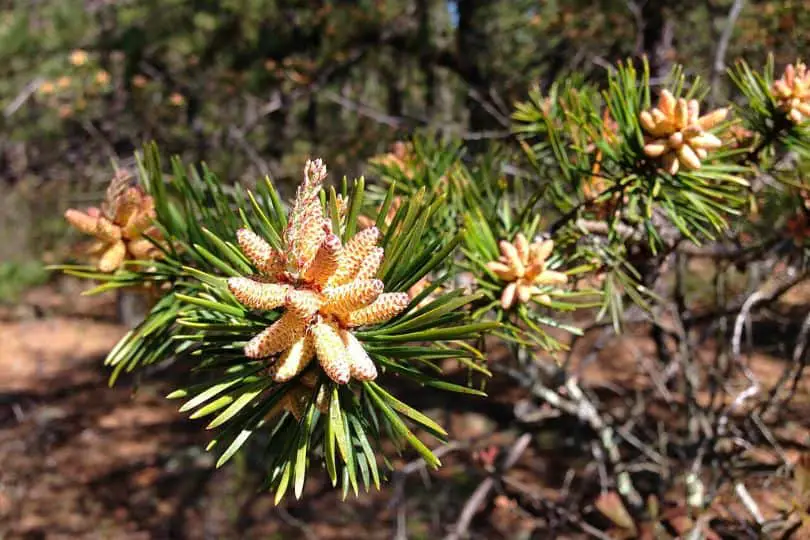
- Scientific Name: Pinus virginiana Mill.
- Common Name(s): Virginia Pine, Scrub Pine
- Mature Height: 40-50 feet (12-15 meters)
- Native Region: Southern species, northern limit in Pennsylvania
- Flowers: No Flowers
- Fruit: Cones 2-3 inches (5-7.5 cm) long, with small sharp prickles, remaining attached for 3-4 years
- Uses: Valuable for cover on worn-out farmlands, harvested for pulpwood, seeds eaten by squirrels, songbirds, and game birds, a caterpillar food source for the eastern pine elfin butterfly.
The Virginia Pine, also known as Scrub Pine, is a tiny tree with an irregular shape that can grow to heights of 40-50 feet on sandy or poor rocky soils and is commonly found in barrens and ridgetops. It is endemic to the southern hemisphere and reaches its northern limit in the United States in Pennsylvania. The tree is harvested for its pulpwood and is frequently utilized as a cover for worn-out farmlands.
The Virginia Pine’s leaves are evergreen needles that grow in clusters of two and are 1.5 to 3 inches in length. The twisted and sturdy needles give the tree a distinct appearance. The tree’s twigs are slender, bent, and flexible, with colors ranging from brown to purple to blue to white covering. The buds are egg-shaped, brown, and resinous, and are usually less than half an inch long.
The bark of the Virginia Pine is smooth, thin, reddish-brown, and scaly. It is fissured shallowly into little flat plates. The tree’s cones are around 2-3 inches long and have small yet stinging prickles. The edge of the cone scales frequently contains darker bands, and they do not usually have a stalk. These cones can cling to the tree for 3-4 years.
The Virginia Pine is not fire-tolerant, and it thrives in open, sunny locations. Squirrels, songbirds, and game birds feed on the seeds produced by the tree. Additionally, the caterpillars of the eastern pine elfin butterfly eat Virginia pine needles, pitch, and short-leaf pine.
Because the Virginia Pine prefers sandy or rocky soils, it requires well-drained soil in Pennsylvania landscapes. The tree demands a lot of sunlight and should not be planted in a shaded region. It can be utilized in reforestation initiatives or planted as a cover tree for worn-out farmlands. Once established, the Virginia Pine is relatively low-maintenance and does not require considerable attention. Wateregularlybasis during dry months and occasional pruning to preserve the correct form are usually sufficient.
5. Eastern White Pine
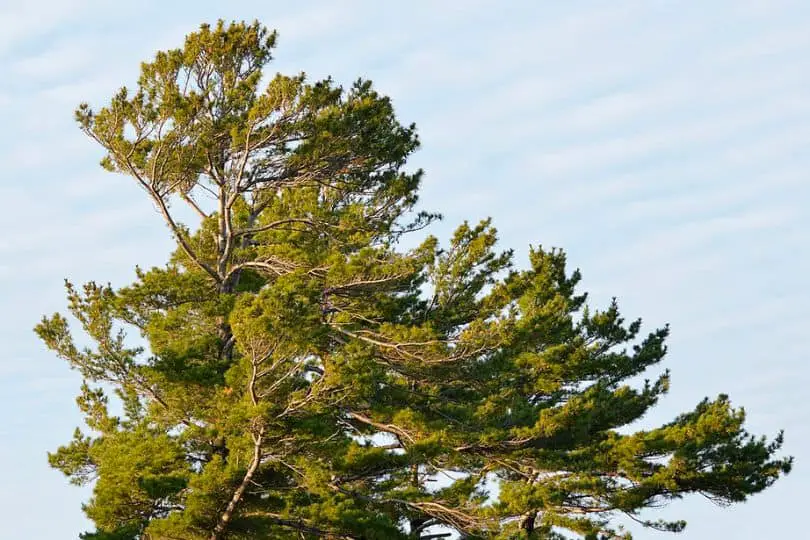
- Scientific Name: Pinus strobus L.
- Common Name(s): Eastern White Pine
- Mature Height: 50′-90′ (15-27 meters)
- Native Region: North America
- Flowers: No flowers.
- Fruit: Cones 4″-7″ (10-18 cm) long, without prickles, slightly curved, with each scale bearing 2 winged seeds.
- Uses: Valuable timber tree, planted as an ornamental, provides food for birds, squirrels, chipmunks, mice, porcupines, and deer browse on the twigs.
The Eastern White Pine (Pinus strobus) is a huge evergreen tree that can grow to heights of 50 to 90 feet (15-27 meters). However, these trees used to grow significantly larger, with some examples reaching over 170 feet in the past. Eastern White Pines are native to North America and can be found in both moist and dry woodlands across Pennsylvania. They are frequently planted as decorative trees in large open spaces.
The physical traits of the Eastern White Pine are distinct. It has silky, flexible needles that are bluish-green and grow in clusters of five needles. In Pennsylvania, these clusters are peculiar to this species of pine. Eastern White Pine cones are resinous, somewhat curled, and range in length from 4 to 7 inches (10-18 cm). Each cone scale normally contains two winged seeds, which are typical of the region’s native pines.
The Eastern White Pine thrives in a wide range of environmental conditions. It can grow in both moist and dry forests and tolerates a wide range of soil types. The twigs of the tree are slender and flexible, with immature twigs covered in rusty hairs that eventually smooth off. This tree’s bark is initially greenish-brown on young trunks and branches, but it darkens, becomes grooved, and scaly as it ages.
The Eastern White Pine has a variety of uses and is ecologically significant. It is highly regarded as a timber tree, with its wood used for building, cabinetry, and furniture. It has a grand presence in bigger landscapes as an ornamental tree. The tree is also extremely beneficial to wildlife. Many birds, squirrels, chipmunks, and mice eat on the soft needles and seeds of the pine. Furthermore, porcupines favor the inner bark of the Eastern White Pine as a winter food source, and deer feed on the tree’s twigs.
Eastern White Pines in Pennsylvania gardens require well-draining soil and plenty of sunlight for best growth. These trees require little upkeep and can grow in a variety of soil types, including sandy, loamy, and clay soils. Regular watering is required during the establishing period, although the tree can endure dry circumstances once established. Pruning is not usually necessary, but removing any damaged or diseased branches can help keep the tree healthy and attractive.
6. Scots Pine
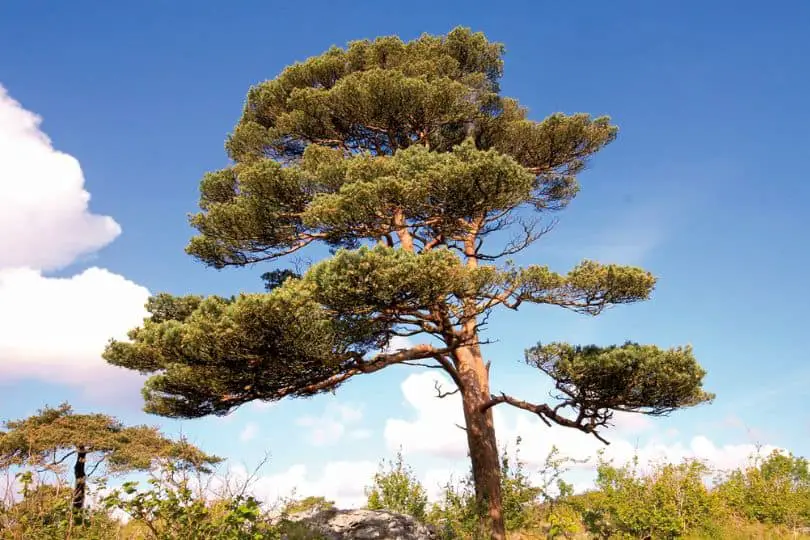
- Scientific Name: Pinus sylvestris L.
- Common Name(s): Scots Pine, Scotch Pine
- Mature Height: 70 feet to 120 feet (21.3 meters to 36.6 meters)
- Native Region: Europe
- Flowers: No Flowers
- Fruit: Cones 1½”-2½” long, grayish or reddish color
- Uses: Widely planted for reforestation and horticulture, occasional escapes from cultivation
The Scots Pine, also known scientifically as Pinus sylvestris, is a tall evergreen tree native to Europe. It is also referred to as Scots Pine or Scotch Pine. This tree can mature to a height of 70 to 120 feet (21.3 to 36.6 meters) with a diameter of 3 to 5 feet. The Scots Pine is commonly planted for forestry and horticulture, and it does occasionally escape.
Scots Pine leaves are needle-like and grow in clusters of two. These needles are thick and twisted, measuring 112 to 312 inches in length. They are either bluish-green or dark green in hue. This tree’s twigs are fairly robust and brittle and have a dark yellowish-gray tint. Scots Pine bark is scaly and peels off in flakes from ridges divided by long, shallow cracks. The bottom trunk is rough and grey in appearance, whilst the top trunk is reasonably smooth and has a pronounced crimson hue.
The fruit of the Scots Pine is in the form of cones. These cones range in length from 112 to 212 inches and are grey to reddish in hue. They have short stems and typically point backward. The Scots Pine is tolerant of a variety of soil and moisture conditions, although it is not tolerant of shadow. It is most typically seen in Europe, although it has also been widely planted in other parts of the world.
Because of its resilience to diverse soil and moisture conditions, the Scots Pine might be a good choice for Pennsylvania landscapes. It prefers full sunlight and does not do well in partial shade. The mature height of the tree and its lovely pine needles make it an eye-catching addition to gardens and landscapes. However, because the Scots Pine can escape cultivation, suitable precautions must be taken to restrict its growth and prevent it from becoming invasive.
The Scots Pine requires little upkeep in terms of care. Once grown, it is drought-tolerant but requires regular watering, especially during dry times. The tree likes well-drained soil and will not tolerate standing water. Pruning is only required if you want to shape the tree or remove dead branches.
Similar Articles
- Common Flowering Trees In Pennsylvania
- Common Maple Trees In Pennsylvania
- Common Cherry Trees In Pennsylvania
- Common Locust Trees In Pennsylvania
- Common Nut Trees In Pennsylvania
- Common Cedar Trees In Pennsylvania
- Common Palm Trees In Pennsylvania
- Common Birch Trees In Pennsylvania
- Common Aspen Trees In Pennsylvania
- Common Oak Trees In Pennsylvania
- Common Ash Trees In Pennsylvania
- Common Elm Trees In Pennsylvania
- Common Spruce Trees In Pennsylvania
- Pink Flowering Trees In Pennsylvania
- White Flowering Trees In Pennsylvania
- Purple Flowering Trees In Pennsylvania
Common Pine Trees In Pennsylvania – Sources
The Regional Gardening team makes sure that the information in our articles is accurate by only using sources that are known to be trustworthy. Some of these sources are peer-reviewed journals from government agencies, well-known universities, and scientific research organizations.
- Native Plant Resources, Pennsylvania Native Plant Society
- Trees & Shrubs Varieties, PennState Extension
- Landscaping With Natives, Pennsylvania Department Of Conservation, & Natural Resources
- Explore Pennsylvania Forests, Pennsylvania Department Of Conservation, & Natural Resources


